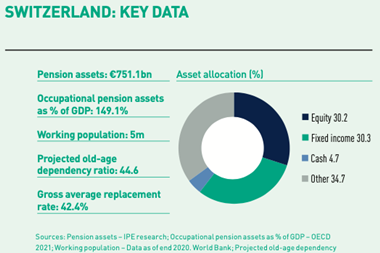An increasing number of companies listed on the Swiss Leader Index (SLI) is offering second pillar 1e pension plans, according to a study conducted by Willis Towers Watson (WTW).
The result of the study revealed that almost 35% of the companies surveyed, listed on the SLI, now offers these plans. The SLI includes firms listed on the blue chip index Swiss Market Index (SMI) and the 10 largest mid-cap stocks listed on the SMIM.
WTW noted that only a few years ago “hardly any” large or mid-cap company in Switzerland offered these types of voluntary occupational pension funds.
According to the research, less than 5% of the firms examined for the 2017 study listed on the SLI offered 1e plans, while in 2019 the rate was between 20-25%.
Under 1e plans people with a minimum annual salary of CHF126,900 can choose up to 10 investment strategies.
Last year, a survey conducted by PwC showed that assets under management of Swiss providers of second pillar 1e plans grew by 31% year-on-year to reach CHF5bn (€4.6bn) at the beginning of 2020. Providers of 1e products expect assets to grow 15% annually to CHF10.1bn in 2025.
With 1e plans savers have the opportunity to achieve higher returns especially at a younger age when they tend to opt for more aggressive investment strategies.
As a result, WTW said, 1e plans can lead overall to “significantly higher returns” on average compared with classic pension plans. The individual, however, bears the costs in case of losses.
Another popular option relates to the so-called ‘elective’ savings plans, which allow a saver to choose the contribution amount into a pension fund between a maximum of three investment options based on the individual’s financial situation, WTW found.
The consultancy revealed that 90% of the companies surveyed offer elective savings plans compared with 60% six years ago.
Individualized pension plans may offer at first glance an alternative to the classic form of savings and investments through pension funds. Swiss Pensionskassen have in fact cut conversion rates used to calculate pension pay-outs in recent years or plan to do so, which leads to pension losses for members.
According to WTW’s study, however, the conversion rates of the pension plans taken into account have stabilised to an average of around 5.2%.
Savings contributions have also remained stable as projected retirement pensions have not declined further, it said.
WTW has analysed pension plans of 24 out of 30 companies on the SLI.










